I like doing end of unit tests – there, let me put my point of view out there right from the start!




I like doing end of unit tests – there, let me put my point of view out there right from the start!

As we begin the 2nd half of the summer term we are confronted by 4 scenario’s…

Now this may not be a problem with your class – but for other colleagues it may well be.
It can be one or two individuals or groups or even the whole class that seemingly cannot just go out to play at break or lunchtime without causing problems.
You may say “there are staff on duty who can deal with things,” and yes that’s correct, but only to a point. So where does the problem lie and just who needs to sort things out?
For the majority of the time the staff on duty are more than capable of dealing with everything that happens when the children are outside. Small arguments, accidents and even minor mediation are all dealt with quickly and easily and the majority end there. If there is anything that needs to be passed on to you as the class teacher then they will pop into your classroom after the break or catch you as the children line up.
But let’s just say for arguments sake that your class has a few “characters” in it, that can potentially cause some upset if given the chance….I think that’s a polite way of putting it – don’t you? Through your classroom management and behaviour management strategies their behaviour in class if fine and a gentle reminder every now and then keeps them in line. That’s how it works – both sides (you and the child / children) know and understand the status quo and at the end of the day they know who’s running the show!
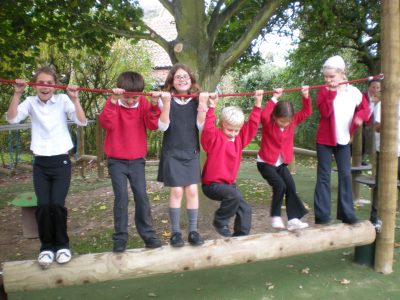
Once outside, certain children have the potential to cause problems for the staff on duty – some more regularly than others. So what can be done and just how far do we, as class teachers, have to be involved?
It really does depend on 2 things:
In most Primary schools there will exist a school behaviour policy – whether this is active and working well really depends on the school. In most cases (but not all) the behaviour policy is an over arching statement that brings together the principles of behaviour expectations but does not go into individual class interpretations. So in reality we have each class making their own interpretations of the policy but under the umbrellas of the main school statements.
The right and wrong approach:
It is absolutely right and correct that any member of staff at a school can deal with a problem of behaviour or situation that they may encounter during the school day. It is also correct that this should apply to any pupil within the school. So for example if a child from another class is running down the corridor then I would expect any teacher to stop the child and speak to them. Likewise if a problem occurs in the dining hall or playground then I would reasonably expect a member of staff (and that includes T.A’s) to deal with the problem and if necessary report it to the class teacher.
(Of course for serious situations the reporting level can move immediately to senior management level.)
In the course of events, most problems can be dealt with easily and without recourse to the class teacher. However for persistent offenders(I sound like the hanging judge here!) or a more serious incident then the matter will be reported to the class teacher who can deal with the matter.
The wrong approach (in my opinion):
I say this as it always used to annoy me slightly when this happened.
When something has happened outside and the colleague has dealt with the matter but has imposed a sanction on the child and then tells me about it. The thing that used to annoy me was when the sanction involved me! So I would be told ” Peter was behaving badly at lunchtime today so I told him he can miss 10 minutes of tomorrows lunchtime!”….hang on who is going to have to supervise this – I have just been committed to keeping Peter in for an incident I have not seen or judged – or, as another example, when the punishment is way over the top for the incident and then I am being expected to enforce it!
We used to have a music specialist who came into school – my class at the time were quite a good class but would always mess about when he arrived. His problem was that he had no idea about class control but would throw sanctions out like confetti. At the end of the lesson I would be committed to keeping in 7 or 8 children because of his useless class control. In the end I gave up and took some work into the class and sat at the back to “ride shotgun!”
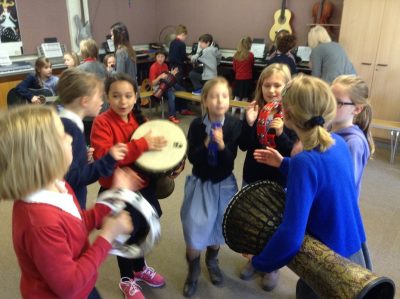 (I put this in as a tribute to all music specialists and no this is not one of his lessons!)
(I put this in as a tribute to all music specialists and no this is not one of his lessons!)
Working together:
The person who knows your class best is you – you have a special relationship with all members of your class and all pupils know and understand the levels of expectation that you have set for both work and behaviour. In order for these expectations to extend beyond the classroom you have to work effectively with all colleague’s in the school. The way in which you work can be different for each and every one of them and only you will know what works for both you and them. For some colleagues you will know that you are happy for them to place a sanction on a pupil for something that has happened. You know this is ok because you know both the experience and approach of that person and they, in turn, know how things operate in your class and also your expectations. For others it is perhaps best to ask them to report to you any misdemeanours that may occur …either immediately or following the break. In these cases let the member of staff know that the matter will be dealt with (and I always informed them as to what I had imposed) and to thank them for bringing it to your attention.
Ultimately the responsibility for the behaviour of your class is down to you – whether this is in the classroom or during playtimes, lunchtimes or even with supply teachers. Children should see staff at school as working together and learn to respect all staff in whatever interactions may occur. It is up to you as the class teacher to make sure that happens for your class and that you are seen to support colleagues at all times – in this way the school and staff present a united front to both pupils and parents and that’s the way it should be.
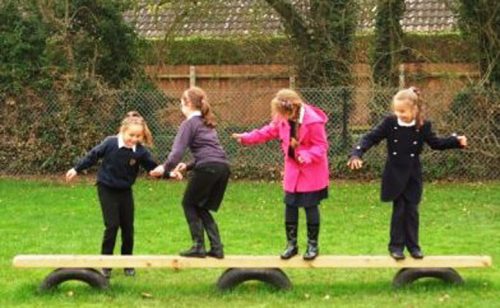

Is it possible to integrate older reading books into our class library and reading scheme or should we just be throwing them out?

I have to say I can’t write about this subject without a smile on my face – so don’t expect a scientific analysis in anything I write!

I visited a school a couple of weeks ago and they were obviously having a bit of a clear out – there was a skip at the side of the school full of rubbish and on top I was surprised to see some whiteboards…nothing wrong with them just surplus to requirements! I have to say I was tempted to ask for one!
With the almost total fitting of Smart boards of every type and brand in classrooms it seems that the days of the whiteboard are numbered – well they certainly were in this school! But is it really progress to get rid of them altogether or do they still have a place in our classrooms?
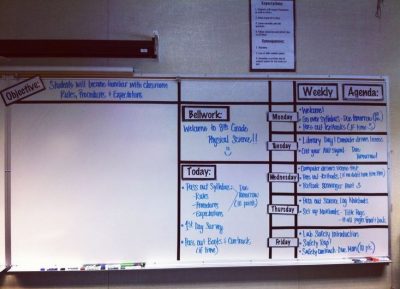
I like a whiteboard – there I have said it….no I really do, and I am not convinced that removing them from classrooms is a good thing. So let me explain my argument –
Now I am not saying that I dislike smart boards (for want of a generic name) – I understand their versatility and all the exciting options that they bring. But they do bring with them some disadvantages and limitations and I am never too sure about the health aspects of large TV screens being on all day! ( I have written about this in another article – linked below)
http://pp.distractweb.co.uk/2016/11/18/class-screens-what-do-we-see-in-them/
However lets consider some of the advantages of whiteboards and why I like having one in a classroom.
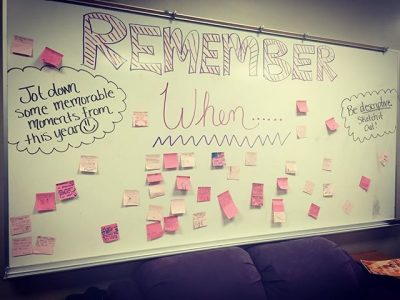

As you can no doubt tell by now, I like having a whiteboard in my classroom – I certainly always had a whiteboard in my HT’s office and I even have a whiteboard in my kitchen at home!
But in saying this about whiteboards does not mean I am not in favour of smart boards in classrooms. In fact quite the opposite. The inclusion of these type of boards brings with it new and exciting elements and experiences to the education of the children and allows teachers to use the vast array of resources available both from the internet and also specific to the technology itself.
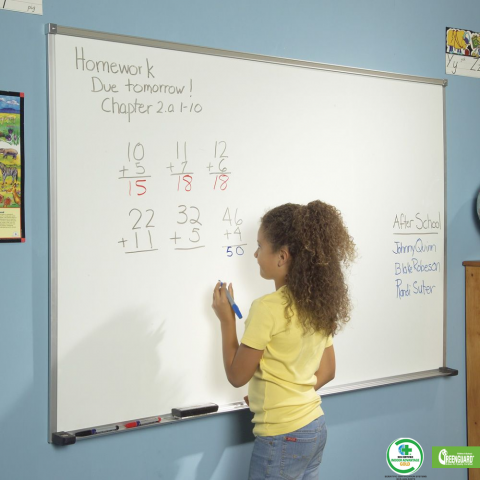
But and it’s a big but – in my opinion it is a mistake to replace whiteboards with the new smart boards. There is a definite place in the classroom for both these resources and it should not be a choice of one at the expense of the other.
Many schools are now starting to realise this and I know of 3 schools who have bought new whiteboards to replace those they had previously removed.

With a bit of careful planning and rearrangement both can be productively used in both extending and consolidating the classroom learning experience.


Do you use a carpet sitting area in your classroom – do you physically have the space to create one and are they really worth having?

Its not very often that I venture into teaching or lesson content as Primary Practice is really all about the practicalities of schools, classrooms and being a teacher.
However I thought today I would give a few thoughts on the teaching of spellings in Primary schools as it has changed markedly over the years and I have to say for the better!
These are broad based thoughts and not in any way definitive – each school will have its own approach to the teaching of spelling and its own combination of strategies – if it works then that’s all that matters.
The National Curriculum requirements:
The guidelines on spelling are really split into 2 sections – one for each key stage.
In key stage 1 the teaching of sounds and patterns is prominent however it is also said that the words given as examples including the exception words should really be taught.
At key stage 2 the word list are statutory and some guidance is given to support their teaching. The NC recommends that phonics teaching is continued as well as the relevance between meaning and spellings.
Spellings are now tested in the KS2 SAT’s in Year 6.
The requirements as set out in the national curriculum are pretty specific and this therefore necessitates that schools must have an organised and progressive approach to the teaching of spelling in order to achieve success in this important area.
There are 4 basic areas involved in a combined approach:
You may use others in your school or they may be variants of the above – but as I have said previously it must be specific to your particular school and the needs of your children.
Phonics:
In my opinion the teaching of phonics now needs to be across the whole school and should not end in KS1.
Many schools have noticed that for varying numbers of pupils their phonic foundations can be poor and of course this leads to increasing problems as the work rate and complexity increases across KS2. In teaching phonics in KS2 it provides opportunity to support these identified children whilst also extending phonics in an active teaching programme.
There are many examples of good phonics programmes that can be used – but for no other reason than I have personally used this one, I will use it as an example here.
The Collins Phonics and Spelling publications extend right across the Primary age range from Rec to Y6 and provides either support for a phonics programme already used in school or as we used it, as a teaching aid for each age group. There are puzzles, games and quizzes. Each level is directly linked to the appropriate spelling objectives and there are differentiation and homework ideas. ( I could almost be on commission!)
Key stage 1 had their own approach to the teaching of phonics based on “letters and sounds” (the gov’t scheme) and Jolly phonics but at KS2 we used to teach phonics every morning for 20 minutes at the beginning of the day based on the Collins scheme.
I have to say that this focus within KS2 had an immediate and positive effect, not only on the pupils spelling but also in their written work and spoken vocabulary.
Links to handwriting:
It is not my intent to delve into the studies and theories behind such links. Most schools now have a taught programme for handwriting across the school. There are proven links between spelling and handwriting and as such, a linked school programme both consolidates and reinforces the taught phonics element incorporated in written spelling patterns.
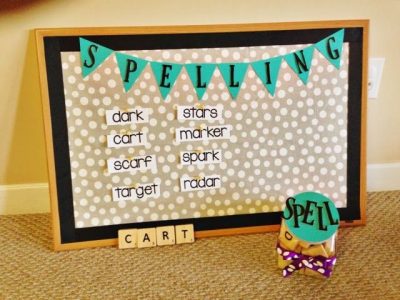
Displays:
Classroom displays are a useful and integral part of the spelling programme – especially if they also incorporate a “working wall” in part of whole.
Displays to reinforce current spelling focus or to encourage spelling challenges or games can bring a colourful and fun element directly into class life which of course is always great!
Not all displays need to directly relate to a taught phonics or spelling programme and topic display boards may contain “topic words” that are important for the children to know and use in their written work.
Here’s a few examples of boards….
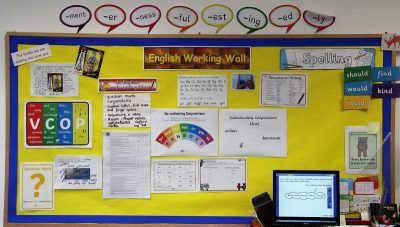

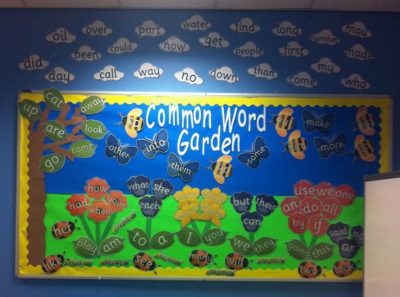 and finally why not go BIG!
and finally why not go BIG!
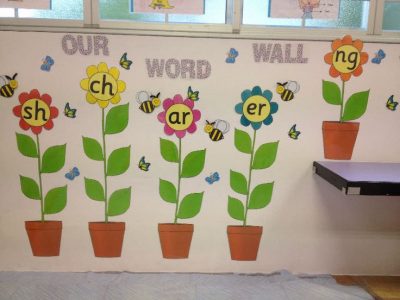
Homework:
Depending on the schools policy towards homework this may possibly provide another option.
Personally I have always sent spellings home to be learnt each week. Using 3 spelling groups in the class, each group was set 10 spellings every Monday to be learnt for a test on Friday. The test not only being on the words themselves but also in sentences to provide context and understanding.
Dependent on the levels and needs of the class; written homework can be set either to indirectly require the use of current phonetic class learning or in some cases, directly to practice and consolidate specific areas.
Again Collins produces Phonic support materials that can be used at home should there be a need for extra support and practice for some pupils..
So there are some thoughts on approaches to teaching spellings in the Primary age range. I am sure that every school will have or will be evaluating their own structures to ensure that all children make maximum progress and achieve success in this vital area. Spellings are a cornerstone of a Childs language; reading, writing, speaking and understanding. They cannot, in my opinion, be taught in isolation as each element is intertwined with all the others – and as such must be taught in a combined approach.
I have seen, on my travels, many many examples of excellent and outstanding practice and have enjoyed hearing and reading examples of terrific work from very proud pupils. It is certainly a testament to the hard work of dedicated colleagues up and down the country and the success speaks for itself.

Charles

We are now heading into the summer term and hopefully warm weather – so here’s a great idea that takes no organising and both you and your class will enjoy!
With all the pressure of tests and curriculum accountability; with report writing looming large and of course all the internal tracking and record keeping, its nice to build in a bit of flexibility into your timetable.
In fact you don’t even have to build it into the timetable – you just decide NOT to do something and do this instead! – and just before you ask…”no it doesn’t replace the P.E curriculum – its just fun times outside in the sunshine!” what could be better?
As the weather warms up there are days when both you and the children look longingly through the windows at the lovely day outside. Inside you are all battling away with some remote and completely boring “parts of speech” in writing that is neither appropriate nor relevant except for its appearance in the curriculum – the summer sun just seems far more appealing!
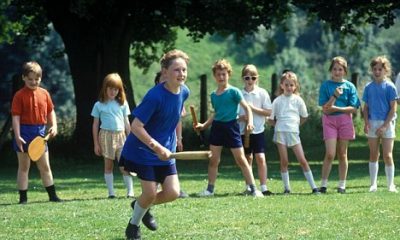
Let’s look at your timetable:
As we all know, the mornings in Primary schools are pretty well structured….usually a starting activity that may last for about 30 minutes before moving in to Maths and Literacy in whatever form this occurs. So it is in the afternoons where we have the flexibility. The afternoons account mostly for the foundation subjects which are spread across the week according to the way that your school balances the curriculum.
This sort of structuring prohibits to a large extent any flexibility within morning sessions so it is to the afternoons where we are looking. From our point of view this is actually much better, as afternoons are more often warmer than the mornings as the day has had a chance to warm up!
Find a box for your class:
 It doesn’t have to be huge but it does have to be strong – so really we are looking at a plastic box rather than cardboard. I am sure if you have a rummage around school you will be able to find a spare box somewhere or even one that is full of rubbish that you can empty and claim! Make sure it has places to grab so that it can be carried easily. If not then take it home (or ask the caretaker) to drill 2 holes at each end and thread some rope through to make handles.
It doesn’t have to be huge but it does have to be strong – so really we are looking at a plastic box rather than cardboard. I am sure if you have a rummage around school you will be able to find a spare box somewhere or even one that is full of rubbish that you can empty and claim! Make sure it has places to grab so that it can be carried easily. If not then take it home (or ask the caretaker) to drill 2 holes at each end and thread some rope through to make handles.

Selecting your equipment:
The equipment that you need to select has to provide for a variety of activities (the reason for this I will explain later). So the types of things you will choose are…
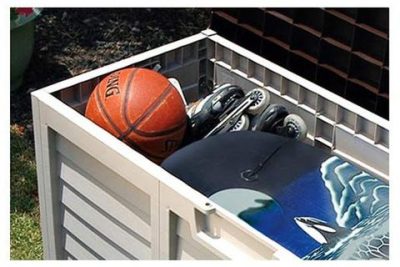
Basically its a selection of sports stuff that you can easily take outside and is suitable for the age of your class. Put all this into the box….if you have any equipment like hoops that you wish to take then obviously these will need to be carried separately!
Because you have only small numbers of things then in most cases it will be ok to leave this box in your classroom. If you do need to borrow anything more substantial then of course you will need to return it after use.
So how does it work…what’s the idea behind it?
Its very simple really and something that adds to the school day. If I had to justify it curricular wise then yes it can be unpicked with many objectives covered – but that’s not the point!
The idea is that, as a class, we have the sports box ready and available – if the weather is really nice and sunny we can decide at any time (I always did this in the afternoons…) just to go outside on the field. Yes we cancelled what we were going to do and just went out!
I found the best time that suited me was around about 2.00p.m / 2.15p.m for about 40 minutes. In this way we could get an hours session in the afternoon (so it was productive) but I could also then say ” ok….let’s go out!”
No need to get changed – if its hot then obviously we wore caps (and cream if necessary) but we just picked up the box and went out.
Don’t organise a thing!
No need to organise anything – just take the box out onto the field and let the children play in the warm sun. There are times when you may wish to do – say a game of rounders but don’t feel pressurised to even do this.
The children will love playing outside in the sunny weather – they can do whatever they wish with the equipment and all you have to do is wander about and check everything is running smoothly. The only thing I ever organised was a cup of tea with my T.A – and to be honest we used to stand and chat.
Because you have the box sorted there is no organising and collection of equipment and because we don’t get changed it is simply a matter of stopping what you are doing and going outside!
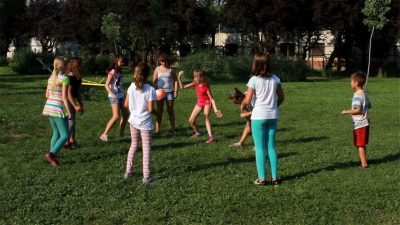
Why it is so good to do:
There are many reasons I can think of:
It’s not something that happens all the time of course – and it does not replace the P.E curriculum. But it’s great just to suddenly decide to drop what you had planned and go outside simply because “it’s such a nice day!”
So as the weather warms up – start filling your sports box and get out there in the sunshine, have fun, enjoy yourself and “catch some rays!”
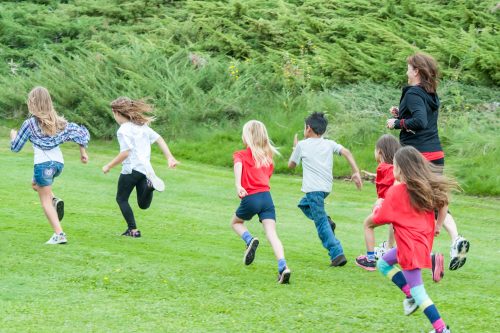
Charles
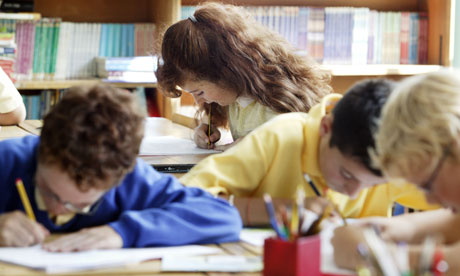
It’s that time of year again when the dreaded tests roll around – with SAT’s completed all schools are feeling quite rightly nervous.